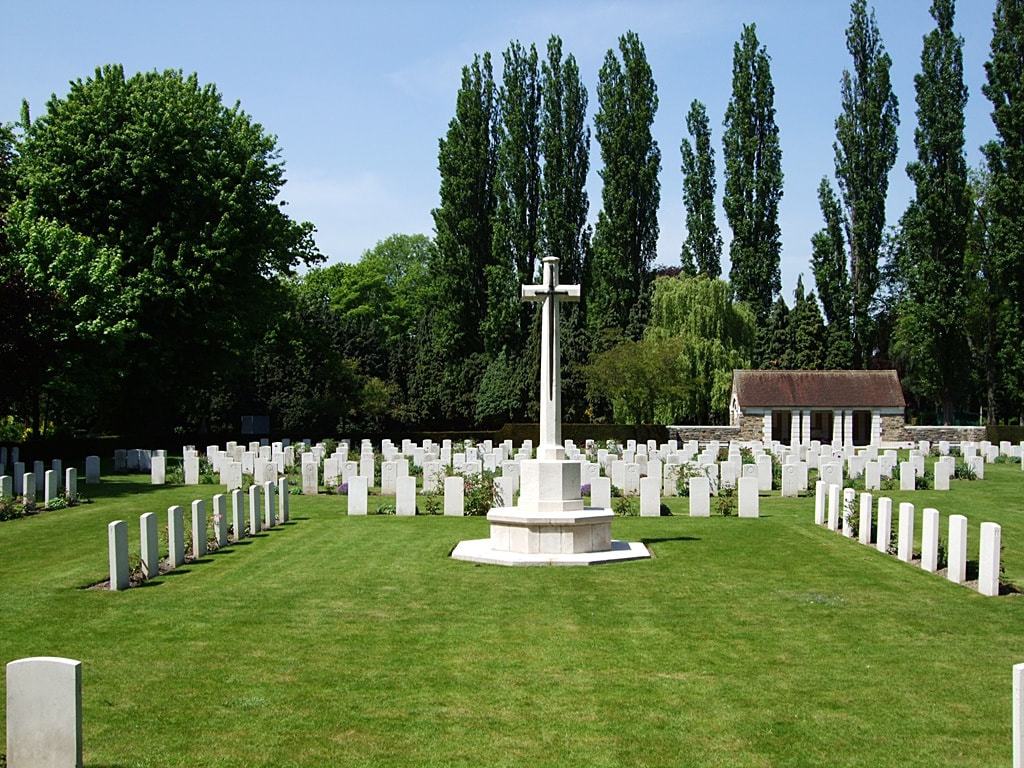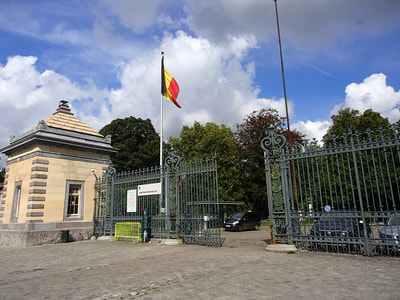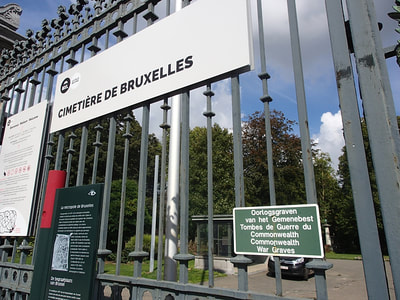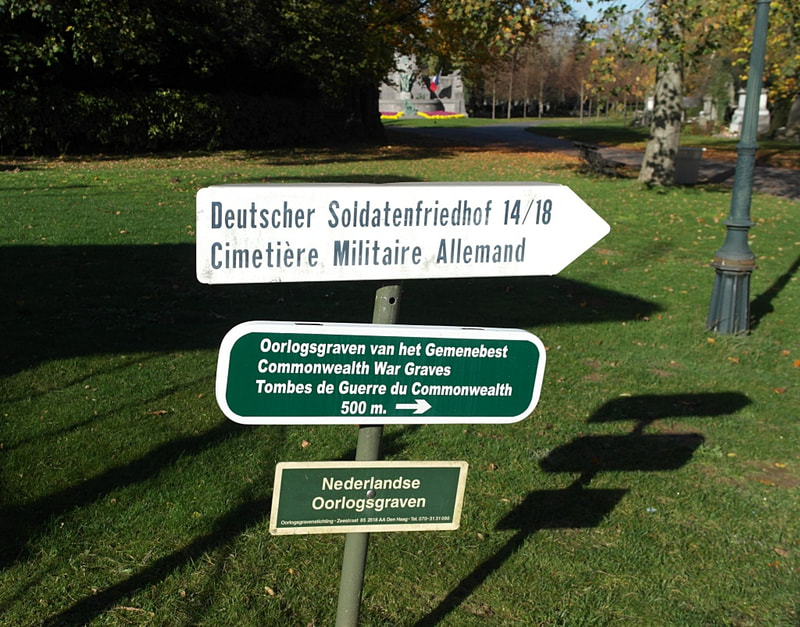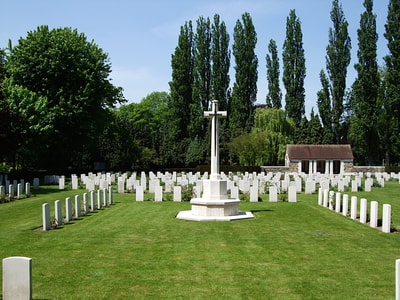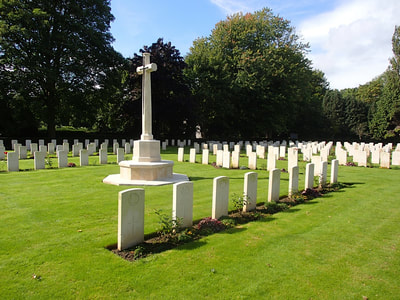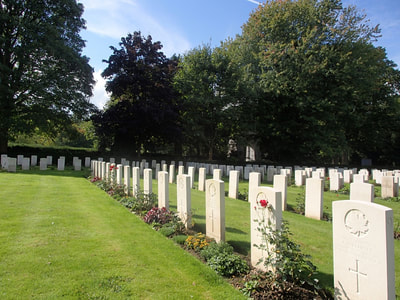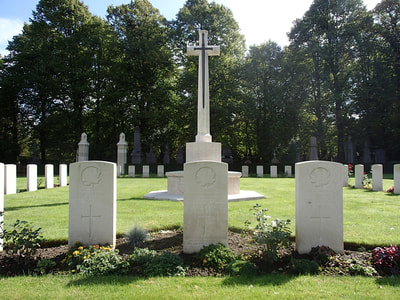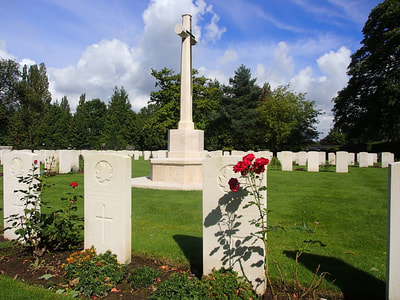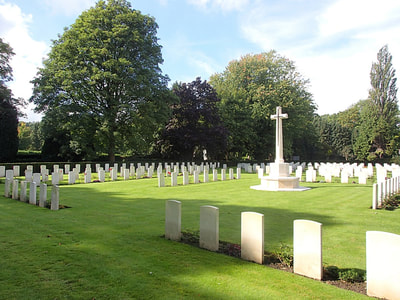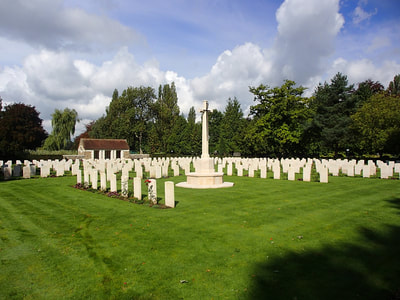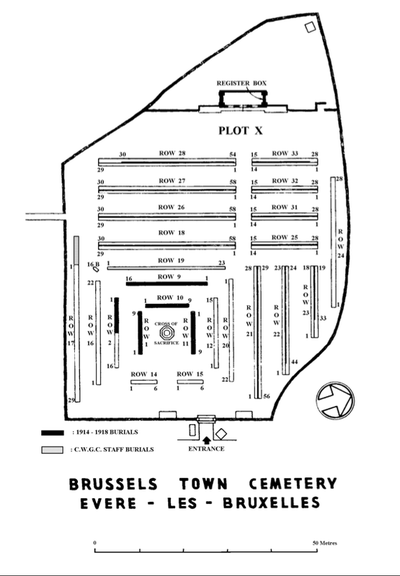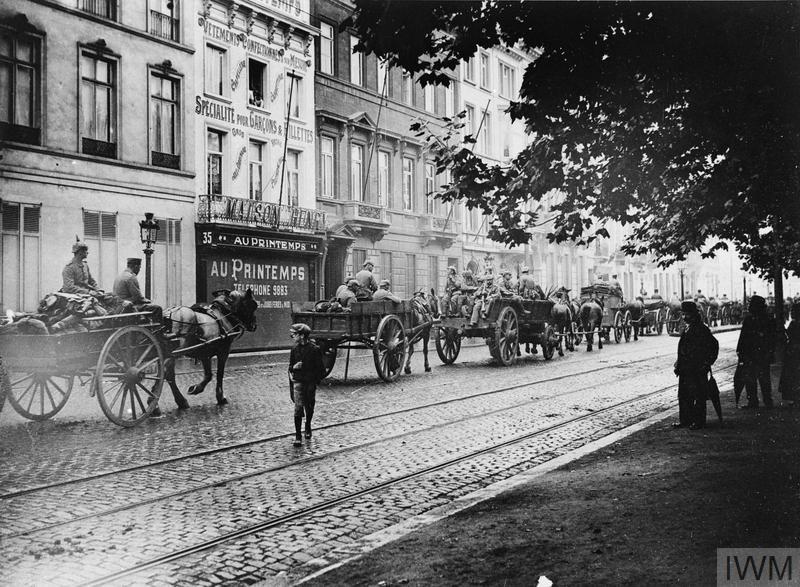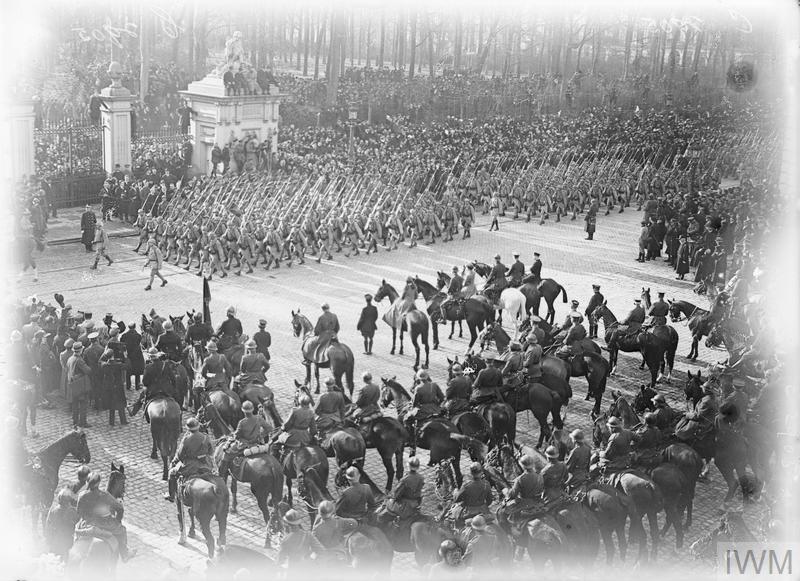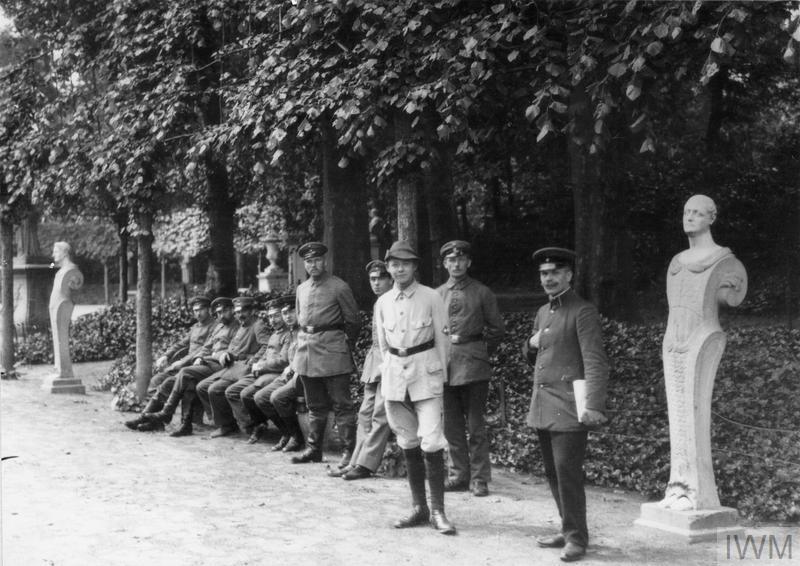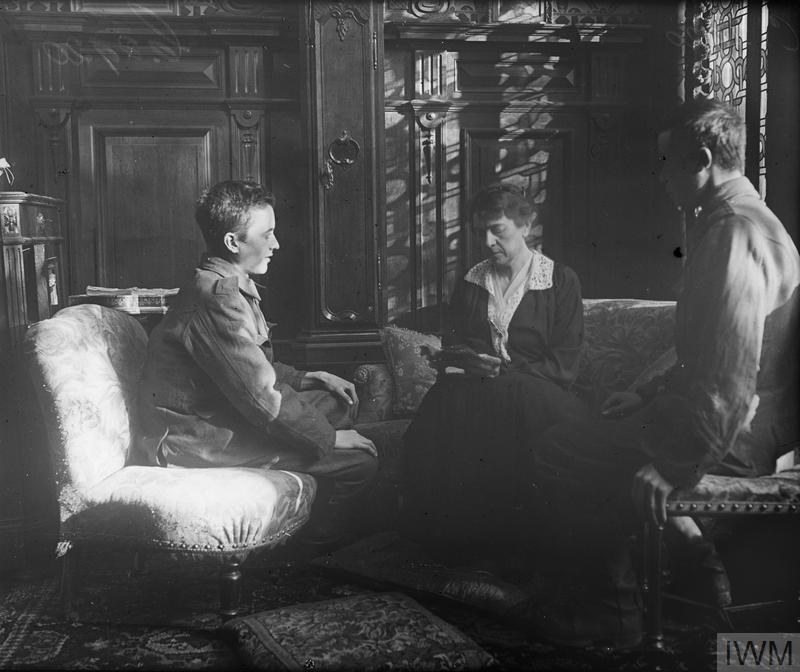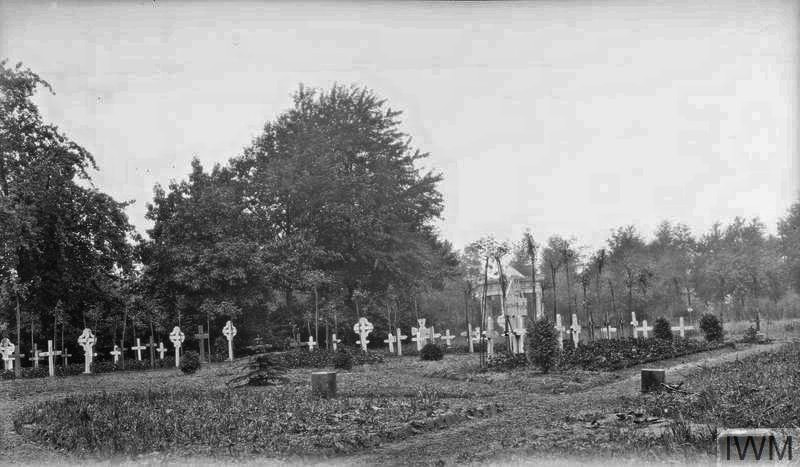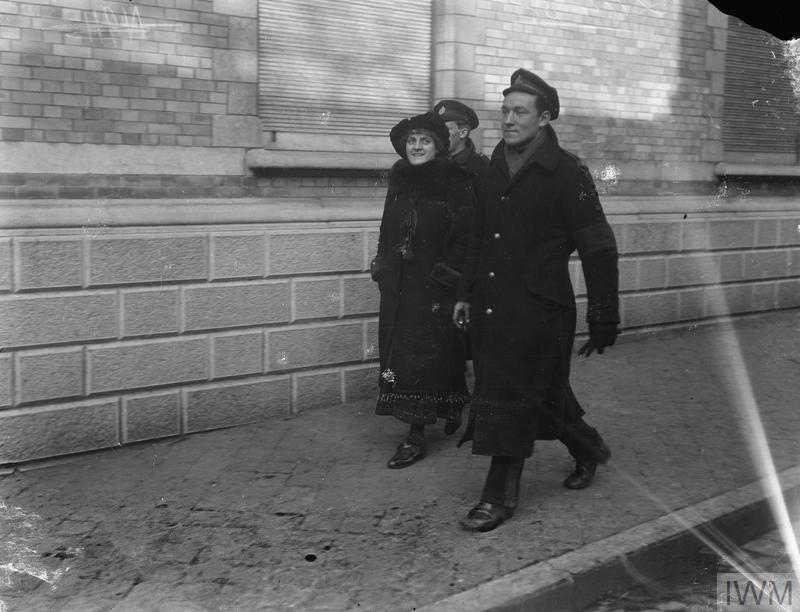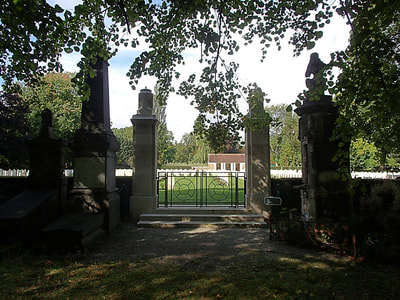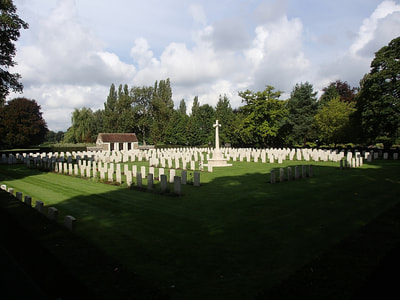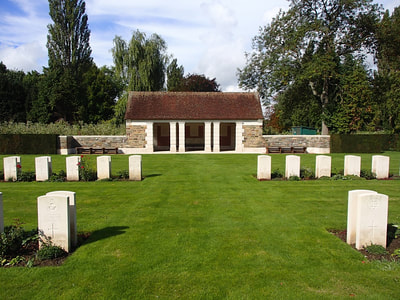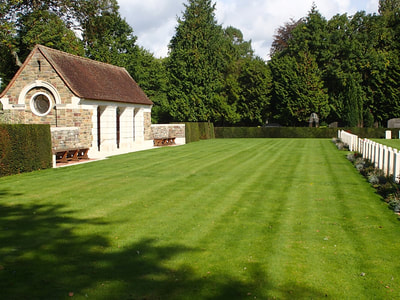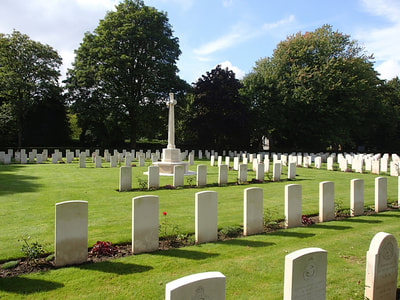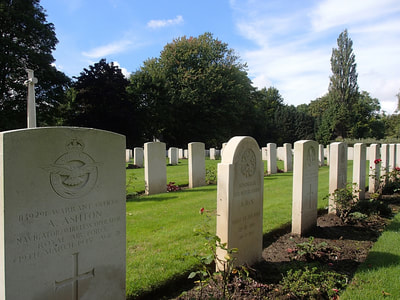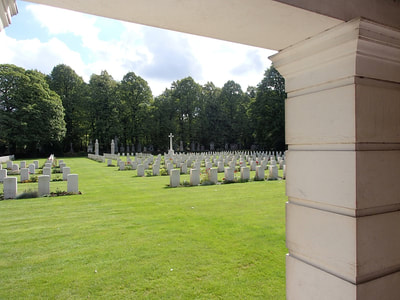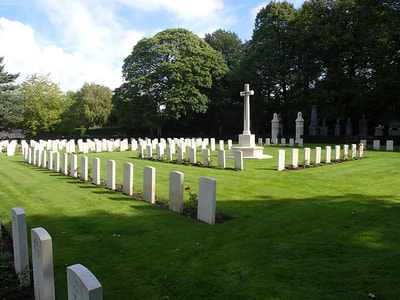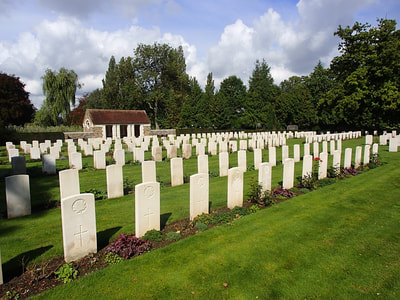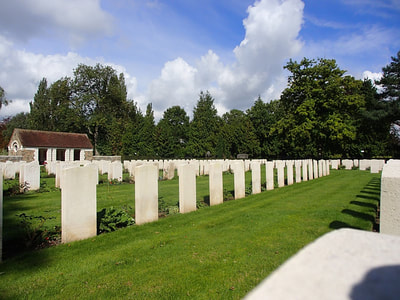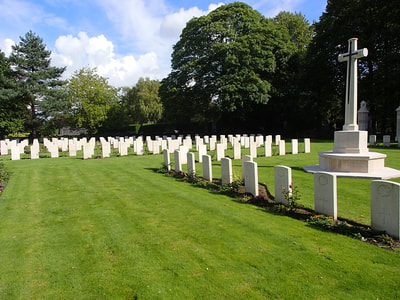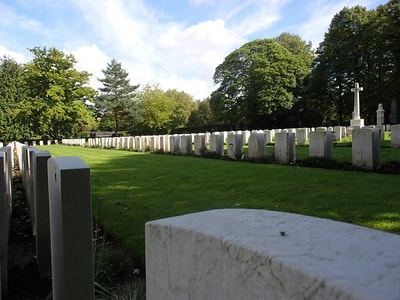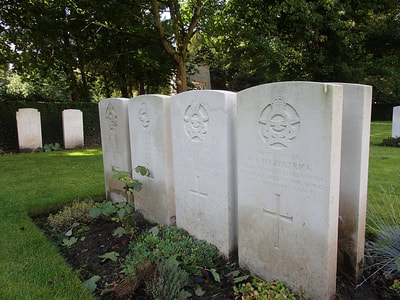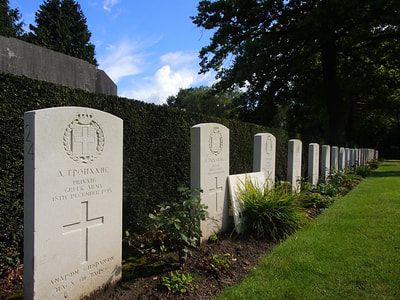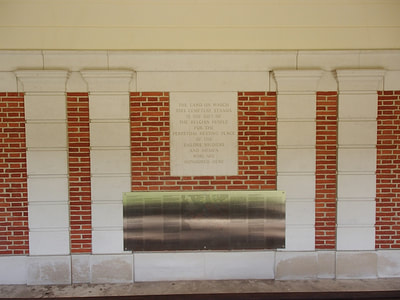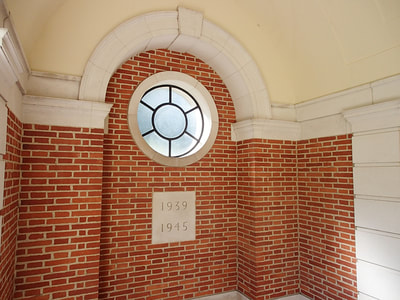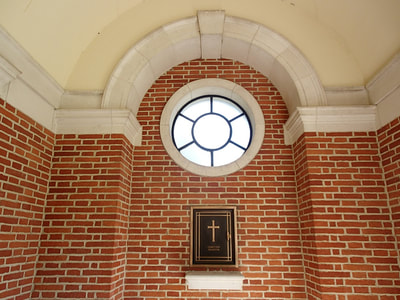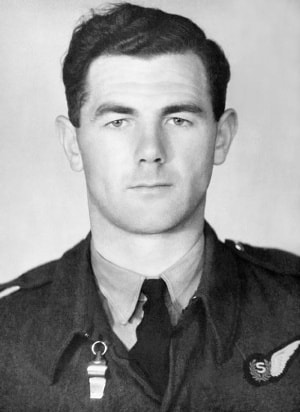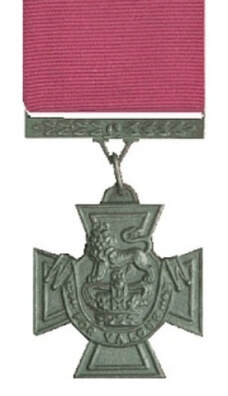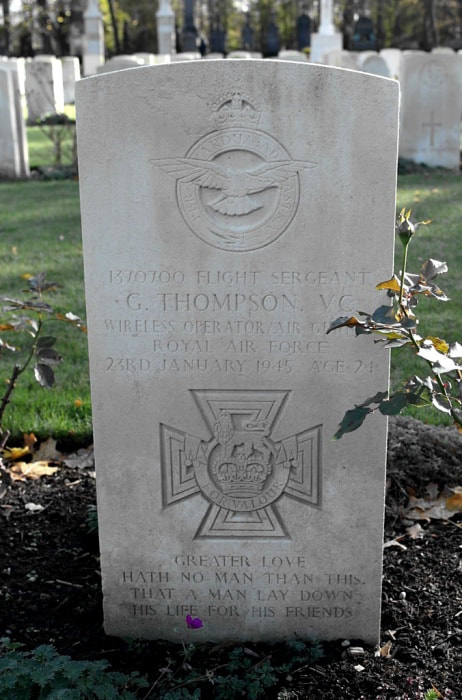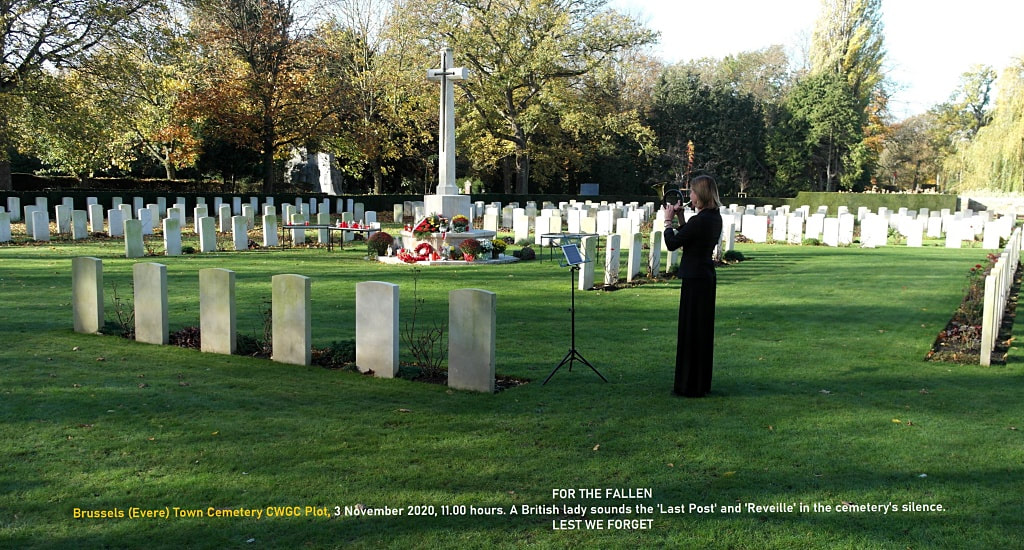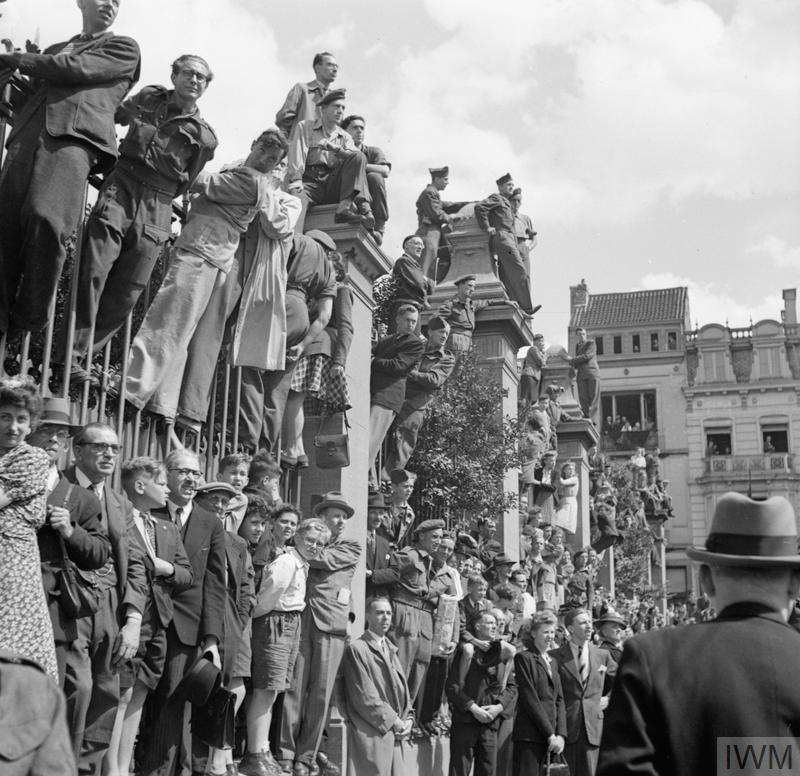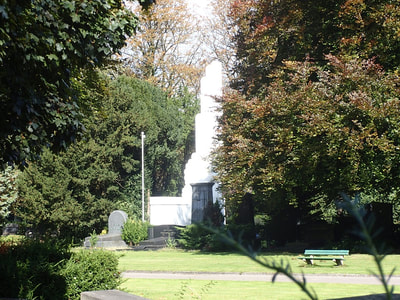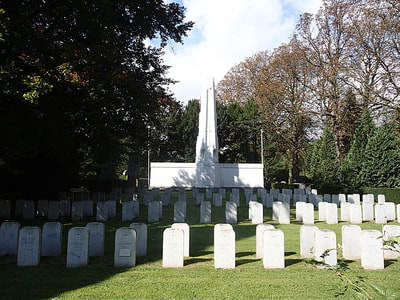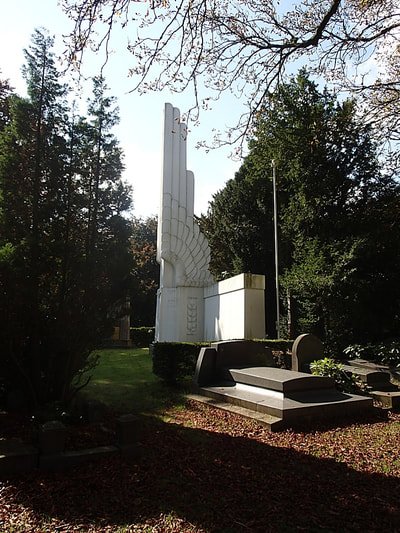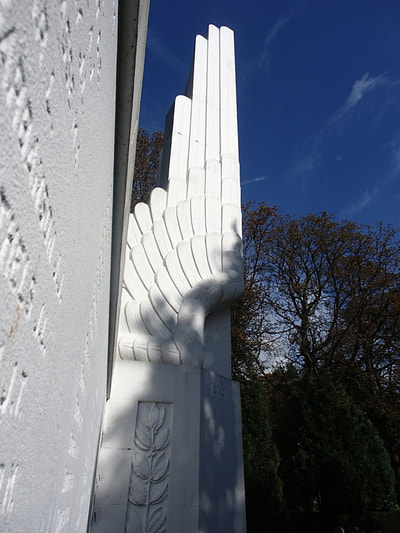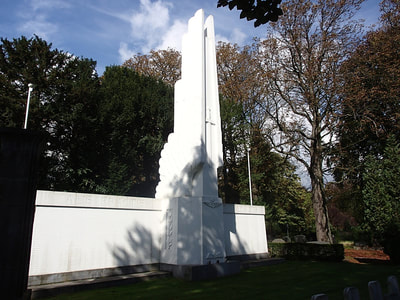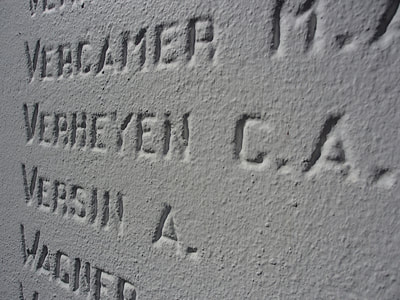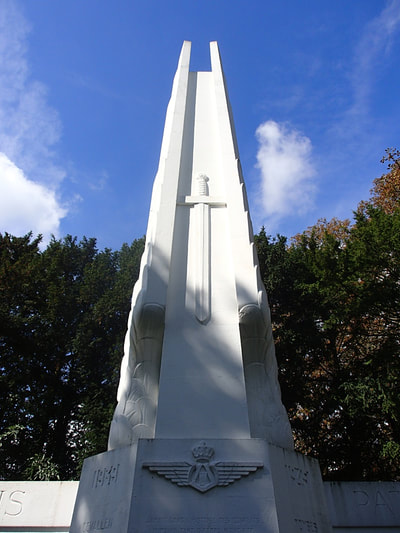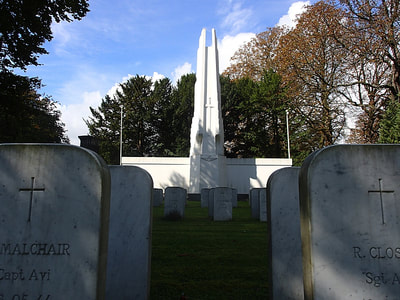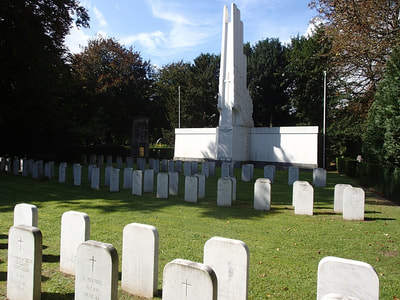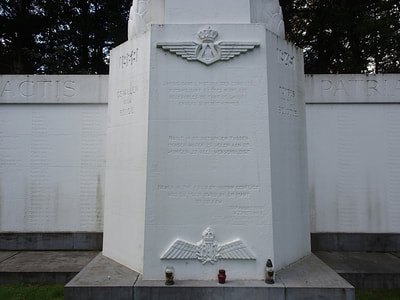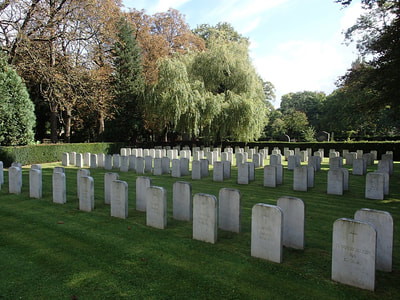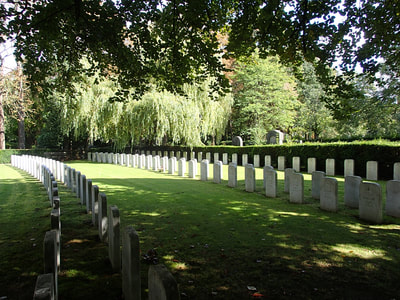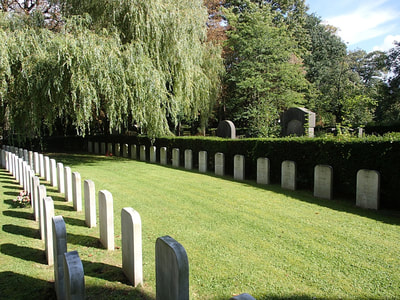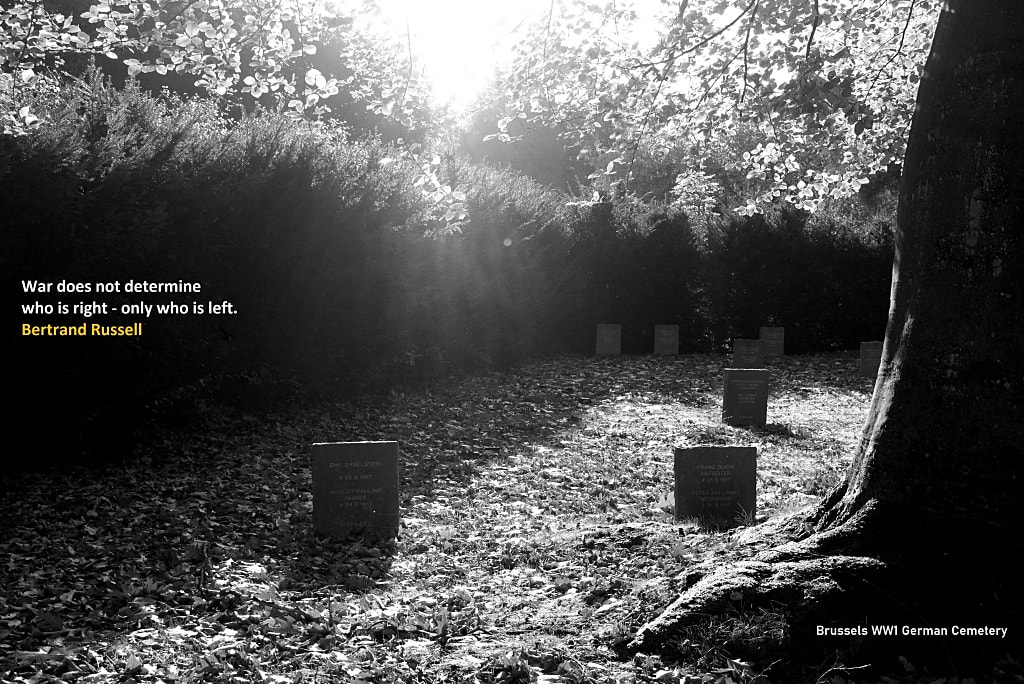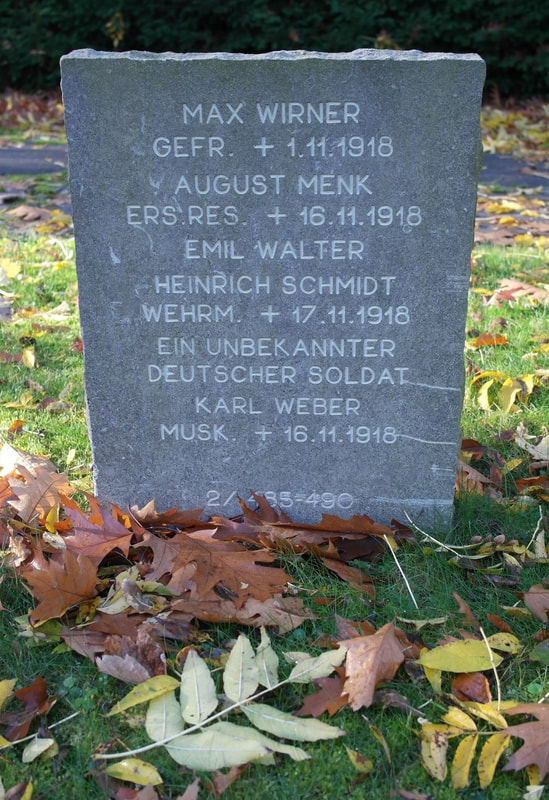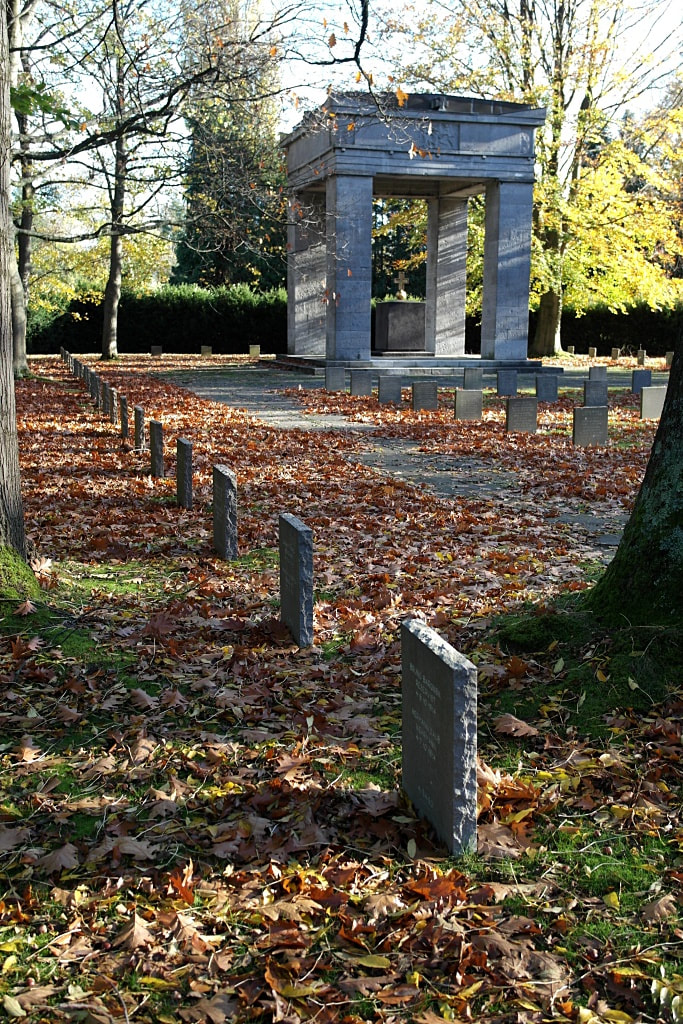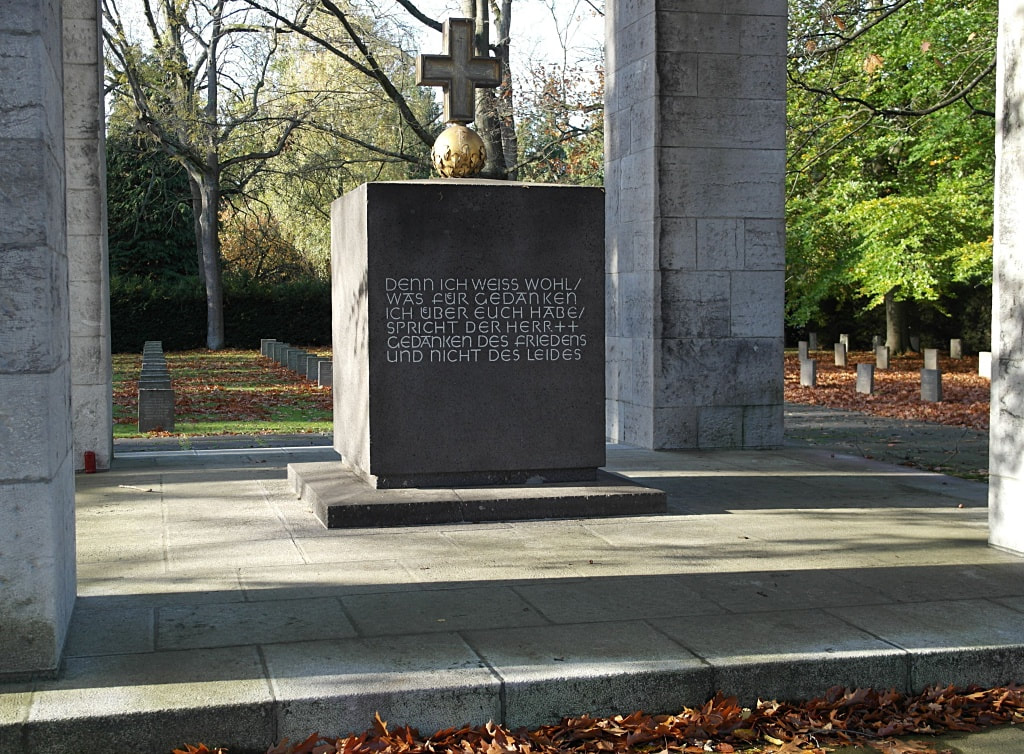BRUSSELS TOWN CEMETERY AND BELGIAN AIRMEN'S FIELD OF HONOUR
Brussels Region
Belgium
GPS Coordinates Latitude: 50.86437 Longitude: 4.41732
Location Information
Brussels Town Cemetery is located in the north east corner of Brussels in the district of Evere. Follow the E40 Brussels-Liege road in the direction of Brussels and leave at junction 19, signposted Woluwe and Evere. Follow the sign Evere to the right and continue 500 metres along the avenue des Communautes to the first set of traffic lights. Go straight ahead here and down the avenue Ciceron to turn left around the roundabout at the bottom of the road. The entrance to the Town Cemetery is then on your right. Follow the main avenue through the cemetery as far as you can go and the Commission plot is on your left.
Visiting Information
The Cemetery Opening Hours are:- Closed on Mondays. Open every other day: 0830 - 1630.
Please Note: Information received from the local authorities at Brussels states that "In accordance with their regulations it is forbidden to photograph headstones, in order to guarantee the anonymity and out of respect to the dead, without prior approval of the local alderman responsible for funerals and burials." However, as the Commission has no objections to photographs being taken or to the filming of our war graves, it is suggested that visitors wishing to do so should make this known to the staff in the office at the entrance of the cemetery.
Wheelchair access to site is possible, but may be an alternative entrance.
Historical Information
Brussels was in German hands from 20 August 1914 to the date of the Armistice. Plot X of the cemetery contains the graves of 54 Commonwealth casualties, 50 of which were prisoners of war whose bodies were brought back from Germany by the Canadian Corps in April 1919.
The British Expeditionary Force was involved in the later stages of the defence of Belgium following the German invasion in May 1940, and suffered many casualties in covering the withdrawal to Dunkirk. Commonwealth forces did not return until September 1944, but in the intervening years, many airmen were shot down or crashed in raids on strategic objectives in Belgium, or while returning from missions over Germany.
Most of the Second World War casualties buried in the town cemetery died on lines of communication duties after the liberation of Brussels at the beginning of September 1944, but a few date from the brief period that the BEF spent in Belgium in May 1940.
Brussels Town Cemetery contains 54 Commonwealth burials of the First World War and a further 587 from the Second World War, 4 of which are unidentified. There are also 35 Foreign National burials here and 5 Non world war Service burials.
World War One Plot designed by George Hartley Goldsmith
World War Two Plot designed by Sir Edwin Lutyens and George Hartley Goldsmith
Total Burials: 685.
World War One Identified Casualties: Canada 50, United Kingdom 4. Total 54.
World War Two Identified Casualties: United Kingdom 493, Canada 74, Poland 21, Australia 9, Netherlands 9, New Zealand 5, Greece 3, South Africa 2. Total 616.
Brussels Town Cemetery is located in the north east corner of Brussels in the district of Evere. Follow the E40 Brussels-Liege road in the direction of Brussels and leave at junction 19, signposted Woluwe and Evere. Follow the sign Evere to the right and continue 500 metres along the avenue des Communautes to the first set of traffic lights. Go straight ahead here and down the avenue Ciceron to turn left around the roundabout at the bottom of the road. The entrance to the Town Cemetery is then on your right. Follow the main avenue through the cemetery as far as you can go and the Commission plot is on your left.
Visiting Information
The Cemetery Opening Hours are:- Closed on Mondays. Open every other day: 0830 - 1630.
Please Note: Information received from the local authorities at Brussels states that "In accordance with their regulations it is forbidden to photograph headstones, in order to guarantee the anonymity and out of respect to the dead, without prior approval of the local alderman responsible for funerals and burials." However, as the Commission has no objections to photographs being taken or to the filming of our war graves, it is suggested that visitors wishing to do so should make this known to the staff in the office at the entrance of the cemetery.
Wheelchair access to site is possible, but may be an alternative entrance.
Historical Information
Brussels was in German hands from 20 August 1914 to the date of the Armistice. Plot X of the cemetery contains the graves of 54 Commonwealth casualties, 50 of which were prisoners of war whose bodies were brought back from Germany by the Canadian Corps in April 1919.
The British Expeditionary Force was involved in the later stages of the defence of Belgium following the German invasion in May 1940, and suffered many casualties in covering the withdrawal to Dunkirk. Commonwealth forces did not return until September 1944, but in the intervening years, many airmen were shot down or crashed in raids on strategic objectives in Belgium, or while returning from missions over Germany.
Most of the Second World War casualties buried in the town cemetery died on lines of communication duties after the liberation of Brussels at the beginning of September 1944, but a few date from the brief period that the BEF spent in Belgium in May 1940.
Brussels Town Cemetery contains 54 Commonwealth burials of the First World War and a further 587 from the Second World War, 4 of which are unidentified. There are also 35 Foreign National burials here and 5 Non world war Service burials.
World War One Plot designed by George Hartley Goldsmith
World War Two Plot designed by Sir Edwin Lutyens and George Hartley Goldsmith
Total Burials: 685.
World War One Identified Casualties: Canada 50, United Kingdom 4. Total 54.
World War Two Identified Casualties: United Kingdom 493, Canada 74, Poland 21, Australia 9, Netherlands 9, New Zealand 5, Greece 3, South Africa 2. Total 616.
World War One Burials
World War Two Burials
1370700 Flight Sergeant George Thompson, V. C.
Wireless Operator in 9 Squadron, Royal Air Force Volunteer Reserve
23rd January 1945, aged 24.
Plot X. 27. 45.
Son of James and Jessie Thompson, of Glencraig, Fife.
His headstone bears the inscription "Greater Love Hath No Man Than This, That A Man Lay Down His Life For His Friends"
Citation
The London Gazette of 16th February 1945 gives the following details : Flight Sergeant Thompson was the wireless operator in an aircraft which attacked the Dortmund-Ems Canal by daylight on 1st January, 1945. Just after releasing its bombs, the aircraft was hit by a heavy shell which set it on fire and caused extensive damage. Flight Sergeant Thompson without hesitation went through the fire and exploding ammunition and rescued the gunners from the mid-upper and rear gun-turrets, both of whom were unconscious. With his bare hands he extinguished their burning clothing. He then with great difficulty made his way back through the burning fuselage to report to the captain of the aircraft. He might have devoted his efforts to quelling the fire, but preferred to go through it to save his comrades, hazarding his life. Three weeks later he died of his injuries. One of the gunners he rescued survived; he owes his life to the gallantry of Flight Sergeant Thompson, whose courage and self-sacrifice will ever be an inspiration to the Service.
Headstone
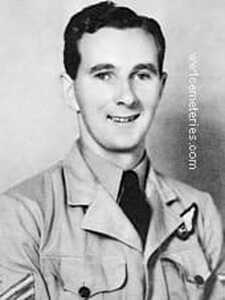
424320 Pilot Officer
Edward Anthony (Tony) Bogan
Royal Australian Air Force
2nd February 1945, aged 21.
Plot X. 27. 54.
Son of Edward Albert and Irene Maud Bogan, of Roxburg, New South Wales, Australia.
He was a pupil at an agricultural college before enlisting in Sydney, NSW on 17 August 1942. He was lost on operations on 2 February 1945. He was the Wireless Operator/Air Gunner on a Mitchell aircraft, FW224. While en route to attack a target in the Netherlands, the aircraft, piloted by Pilot Officer (PO) Ian Hamilton Hicks, experienced engine trouble and crashed at Geerdeghelmveld, near Malines, Belgium, with the loss of all of the crew. At the time of his death he had been granted a commission as Pilot Officer, with retrospective effect from 25 January 1945. He was 21 years old.
Edward Anthony (Tony) Bogan
Royal Australian Air Force
2nd February 1945, aged 21.
Plot X. 27. 54.
Son of Edward Albert and Irene Maud Bogan, of Roxburg, New South Wales, Australia.
He was a pupil at an agricultural college before enlisting in Sydney, NSW on 17 August 1942. He was lost on operations on 2 February 1945. He was the Wireless Operator/Air Gunner on a Mitchell aircraft, FW224. While en route to attack a target in the Netherlands, the aircraft, piloted by Pilot Officer (PO) Ian Hamilton Hicks, experienced engine trouble and crashed at Geerdeghelmveld, near Malines, Belgium, with the loss of all of the crew. At the time of his death he had been granted a commission as Pilot Officer, with retrospective effect from 25 January 1945. He was 21 years old.
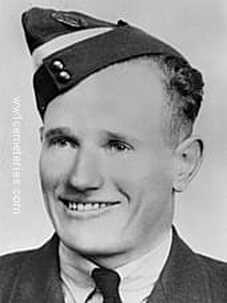
417078 Pilot Officer
Bruce Ian Hamilton Hicks
Royal Australian Air Force
2nd February 1945, aged 28.
Plot X. 27. 52.
Son of Joseph Edmond and Edith Alice Hicks, of Moonta, South Australia.
From Agery, South Australia. A farmer in civilian life, PO Hicks enlisted on 6 December 1941. On 2 February 1945 he was killed whilst serving with 98 Squadron RAF on operations over Belgium. He was aged 28.
Bruce Ian Hamilton Hicks
Royal Australian Air Force
2nd February 1945, aged 28.
Plot X. 27. 52.
Son of Joseph Edmond and Edith Alice Hicks, of Moonta, South Australia.
From Agery, South Australia. A farmer in civilian life, PO Hicks enlisted on 6 December 1941. On 2 February 1945 he was killed whilst serving with 98 Squadron RAF on operations over Belgium. He was aged 28.

415706 Flight Lieutenant
John Trevor McGreal, D. F. C.
109 Squadron, Royal New Zealand Air Force
25th April 1945, aged 32.
Plot X. 21. 53.
Son of John McGreal and of Elsie May McGreal (nee Rogers), of Otahuhu, Auckland, New Zealand; husband of Nora Patricia McGreal, of Sandringham, Auckland.
John Trevor McGreal, D. F. C.
109 Squadron, Royal New Zealand Air Force
25th April 1945, aged 32.
Plot X. 21. 53.
Son of John McGreal and of Elsie May McGreal (nee Rogers), of Otahuhu, Auckland, New Zealand; husband of Nora Patricia McGreal, of Sandringham, Auckland.
Belgian Airmen's Field of Honour
Visiting Information
This Field of Honour is entirely administered and maintained by the Belgian War Graves authorities: Ministerie van Defensie Kwartier Koningin Elisabeth Ter. Dir. - Oorlogsgraven B-1140 Brussels BELGIQUE
History Information
There are over 200 airmen of Belgian Nationality commemorated by headstones in this site. Around 30 headstones among them, marked "disparu", are purely commemorative. There is also a Memorial to Belgian Airmen lost in the Battle of Britain. The 84 named herein are burials of casualties who died as serving members of Commonwealth Air Forces.
This Field of Honour is entirely administered and maintained by the Belgian War Graves authorities: Ministerie van Defensie Kwartier Koningin Elisabeth Ter. Dir. - Oorlogsgraven B-1140 Brussels BELGIQUE
History Information
There are over 200 airmen of Belgian Nationality commemorated by headstones in this site. Around 30 headstones among them, marked "disparu", are purely commemorative. There is also a Memorial to Belgian Airmen lost in the Battle of Britain. The 84 named herein are burials of casualties who died as serving members of Commonwealth Air Forces.

